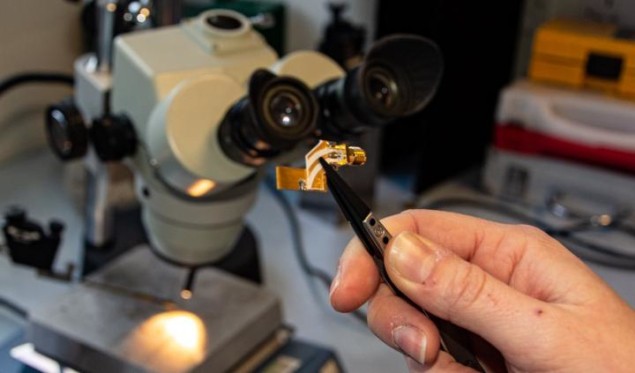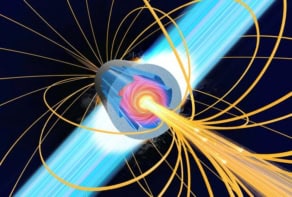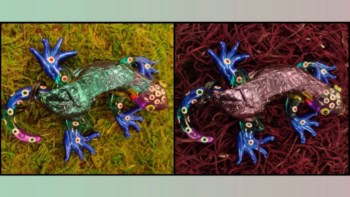
Lasers that switch on and off billions of times per second are the backbone of optical communications networks, but this feat is only possible at certain laser frequencies. A team of researchers from the University of Leeds and the University of Nottingham in the UK has now taken a step towards extending this frequency range by using sound waves to modulate the emission of a terahertz (THz) quantum cascade laser. In this new technique, the modulation rate is limited only by the duration of the acoustic pulse applied, meaning that rates of up to hundreds of gigahertz (GHz) are possible. This could allow data to be transmitted at 100 gigabits per second – around a thousand times faster than current wireless systems.
Although THz signals have a shorter effective range than the microwave signals used in today’s wireless data systems, their higher frequency means they can carry more information over the same time frame. That makes THz radiation promising for ultra-fast, short-range data exchange – for example across hospital campuses, between research facilities at universities or in some satellite communications.
For such a system to be practical, however, the THz laser would need to be modulated extremely quickly – around 100 billion times a second. That has proved challenging, but researchers led by John Cunningham in Leeds and Tony Kent in Nottingham say they have found a way to do it using acoustic waves in THz quantum cascade lasers (QCLs).
Applying acoustic waves
Unlike standard semiconductor lasers, which generate photons when electrons and holes combine inside a material with a given band gap, QCLs consist of dozens of thin layers of semiconductors. Each electron that travels through the device “cascades” through a series of quantum wells in these layered semiconductors, emitting multiple photons as it does so, at frequencies set by the structure of the semiconductor layers. It is this emission process that must be controlled in order to modulate the laser output.
One option is to modulate the output electronically, by applying a bias electrical current to the QCL. However, the maximum modulation rate for such a system is roughly 30 GHz at best. The Leeds and Nottingham team instead used an approach based on acoustic waves. “We generated the acoustic waves by impacting a pulse from another laser onto an aluminium film in the QCL,” explains Aniela Dunn, a research fellow at Leeds and the study’s lead author. “This caused the film to expand and contract, sending mechanical waves through the device.”
Perturbation theory analysis
In effect, Dunn says that these mechanical waves cause the energy levels of the electrons within the QCL’s quantum wells to vibrate. The team explain this process using perturbation theory: by assuming that the effect of the acoustic pulses is small, they can treat the changes to the energy levels as a perturbation to the QCL’s behaviour under normal operating conditions. This enables them to predict how the number and frequency of the QCL’s emitted photons will change in response to the applied acoustic wave.
“By approximating the amplitude of the acoustic (strain) pulse generated in the QCL, we can calculate the effect the sound pulse will have on the energy levels of the QCL,” Dunn tells Physics World. “It is thus possible for us to determine the subsequent effect of the pulse on the voltage across the device and the THz power emitted from it.”

Laser combo opens up futuristic terahertz technology
Application areas
Although the team could not stop and start the flow of photons from the QCL completely, they could control its light output by a few percent – a “great start”, according to Cunningham. In the future, they hope to refine the technique to gain more control over the photon emissions. Dunn adds that they also hope to integrate the sound-generating structures into the THz laser itself, so that no external sound source is needed.
In addition to high-speed communications, Dunn thinks acoustic modulation could come in useful in areas such as high-resolution spectroscopy, active mode-locking and frequency comb synthesis. “Ultimately, it allows us to explore the interaction between THz sound and light waves, something that could have real technological applications,” she says.
The researchers report their work in Nature Communications.


